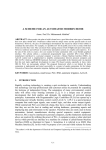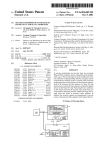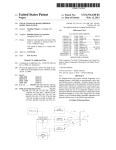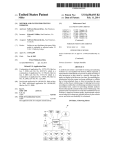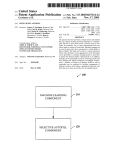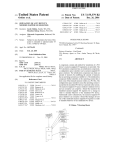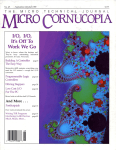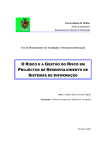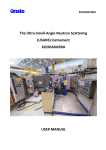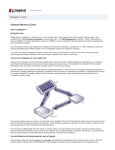Download Graphical user interface
Transcript
US007925611B1 (12) United States Patent Bromley et a]. (54) (75) GRAPHICAL USER INTERFACE Inventors: Clifton Harold Bromley, New Westminster (CA); Monte Leroy Fevang, Surrey (CA); Sha?n A. Virji, Vancouver (CA) (73) Assignee: Rockwell Automation Technologies, Inc., May?eld Heights, OH (US) Notice: Subject to any disclaimer, the term of this patent is extended or adjusted under 35 U.S.C. 154(b) by 899 days. 2002/0070957 A1 6/2002 Trajkovic et al. 4/2003 2003/0107588 A1* 6/2003 Elsbree et al. . 2003/0120714 A1* 6/2003 Wolff et a1. ................. .. 709/200 2003/0174169 A1 2004/0056890 A1 9/2003 TiWari 3/2004 Hoa et al. 2004/0133853 A1* (51) (52) (58) 706/45, 11; 700/17, 83 See application ?le for complete search history. OTHER PUBLICATIONS Jeong-Dan Choi, Ki-Jong Byun, Byung-Tae Jang, Chi-Jeong Hwang “A Synchronization Method for Real Time Surround Display Using Clustered Systems”, Dec. 1-6, 2002, 4 pages. Gordon Stoll, Matthew Eldridge, Dan Patterson, Art Webb, Steven Primary Examiner * Michael B. Holmes Assistant Examiner * Adrian L Kennedy (74) Attorney, Agent, or Firm * Turocy & Watson LLP; Alexander R. KuszeWski; John M. Miller (57) References Cited U.S. PATENT DOCUMENTS 5,610,839 A * 3/1997 5,801,691 A 9/1998 Dahl 6,199,136 B1* 6,282,454 B1* 3/2001 8/2001 Shteyn ........................ .. 710/305 Papadopoulos et al. ...... .. 700/83 6,411,292 B1* 7,013,297 B2 * 6/2002 3/2006 Cook et al. ............ .. Miksovsky .... .. 7,017,116 B2* Karolak et al. ............. .. 455/450 3/2006 Elsbree et al. .. 345/419 706/60 .. 715/740 2002/0046221 A1* 4/2002 2002/0055984 A1* 5/2002 Chang et a1. ................ .. 709/217 Wallace et al. .. ABSTRACT The present invention relates to systems and methods that facilitates rendering of data in an industrial automation envi ronment. According to an aspect of the invention, a device analyzer can determine properties associated With a plurality of devices intended for delivery of data. An HMI generator can format the data respectively in accordance With the deter mined properties of the devices and deliver the formatted data to the respective devices. .... .. 707/513 100 20 Claims, 11 Drawing Sheets x INPUT [- 1 10 120 ? 715/514 Leonik ........................ .. 709/224 * cited by examiner (2006.01) (2006.01) US. Cl. ............................. .. 706/60; 706/45; 706/11 Field of Classi?cation Search .................. .. 706/60, (56) 7/2004 Poerner et al. . 10/2004 345/700 Thomas A. Funkhouser and Carlo H. Sequin, “Adaptive Display Algorithm for Interactive Frame Rates During Visualization of Com plex Virtual Environments”, 1993, 8 pages. Sep. 25, 2003 Int. Cl. G06F 17/00 G06F 17/40 Wong et al. ................. .. 712/220 Berman, Richard Levy, Chris Cay Wood, Milton Taveira, Stephen Hunt and Pat Hanrahan,“Lightning-2: A High-Performance Display Subsystem for PC Clusters”, Aug. 2001, 8 pages. (21) App1.No.: 10/670,582 (22) Filed: Apr. 12, 2011 2003/0070061 A1* 2004/0205185 A1 * (*) US 7,925,611 B1 (10) Patent N0.: (45) Date of Patent: [ — — — - _ — — - — — "' " 1 \ll : | DEVICE ANALYZER | l : ___________ _ _ DATAFORMAT f /— 1 30 ‘ DEVICE1 DATAFORMAT 2 HMI GENERATOR 14o _ / DEVICE2 O O DATAFORMATN DEVICEN / 150 US. Patent Apr. 12, 2011 Sheet 1 0111 US 7,925,611 B1 DATAFORMAT 130 100 1‘ INPUT r110 120 € __________ _ _ \1r 1' } DEVICE ANALYZER: i 1 <——-—1———-—> DEVICE, / DATAFORMAT ___________ _ _ 14o 2 ,_ HMI GENERATOR DEVICEZ . . DATA Fig. l 15o FORWN DEVICEN / US. Patent Apr. 12, 2011 Sheet 2 0111 US 7,925,611 B1 200 W DATA 220 230 i ___________ _ _ I /— 210 \ } DEVICE ANALYZER 1 L __________ _ _} HMI GENERATOR DATAFORMAT PW ¢ H HANDHELD PC (POCKET WINDOWS) DESKTOP PC (WINDOWS NT) Fig. 2 US. Patent Apr. 12, 2011 31 0 1 Sheet 3 0111 US 7,925,611 B1 DATA SENT FROM PHYSICAL DEVICE 320 —\ DATA ggg‘llb/EAgEBY HMI 330 ——\ DATA PROCESSED 350 S-DIMENSIONAL RENIEQING —\ Z-DIMENSIONAL RENDERING US. Patent Apr. 12, 2011 41 o\ Sheet 4 0111 US 7,925,611 B1 DATA SENT FROM PHYSICAL DEVICE l 420 x DATA RECEIVED BY HMI SOFTWARE DATA PROCESSED 440 x 450 ‘ DATA VALUE HALVED 460 X 480 \ (VOLUME/AREA HALVED) DATA VALUE DOUBLED (VOLUME/AREA DOUBLED) 2 465 Y 3 2X3 470 Fig. 4 —/ 2 2X2 490 US. Patent Apr. 12, 2011 Sheet 5 0111 500 —\ /"— 520 US 7,925,611 B1 530 _\ 540 “ A h + VALUE _ 150 UNITS VALUE - 15o UNITS SOFTWARE OBJECT PHYSICAL DEvIcE CHANGE MADE TO CHANGE MADE TO SOFTWARE OBJECTA PHYSICAL DEVICEA . 0 . 0 . 0 ___________________________ c DATA 4 DATA p VALUE - 40o UNITS VALUE ' 15° UN'TS soFrwARE OBJECT PHYSICAL DEVICE CHANGE MADE TO CHANGE MADE TO SOFTWARE OBJECTL PHYSICAL DEVICE, Q Q 0 0 0 0 ___________________________ “J; < DATA > VALUE _ 400 UNITS VALUE - 400 UNITS SOFTWARE OBJECT PHYSICAL DEVICE CHANGE MADE TO CHANGE MADE TO SOFFWARE OBJECTA PHYSICAL DEVICEA Fig. 5 US. Patent Apr. 12, 2011 Sheet 6 0111 610 US 7,925,611 B1 f- 600 ‘\ DATA ENTERED /_ 640 620 FORMAT OF DATA KNOWN’? ARTIFICIAL INTELUGENCE 630 650 —\ DATA PROCESSED 660 ERROR MESSAGE SENT VI EO 670 680 Fig. 6 AU I0 690 / US. Patent Apr. 12, 2011 Sheet 7 0111 US 7,925,611 B1 700 x 71 0 -\ DATA ENTERED 720 \ DEFAULT ZOOM LEVEL ZOOM LEVEL CHOSEN’? DATA RENDEREDA 74o —/ DATA RENDEREDa 750 J Fig. 7 DATA RENDEREDN 760 J US. Patent Apr. 12, 2011 Sheet 8 0111 US 7,925,611 B1 800 x 840 _\\i 850 I x : _ SOFTWARE :: OBJECT GENERATOR I _ _ _ _ _ _ _ w _ _ _ HMI GENERATOR 821 ——/ HMI GENERATOR Fig. 8 __ I US. Patent Apr. 12, 2011 Sheet 9 0111 900 91 0 x DATA ENTERED 920 X DETERMINE DATA TYPE 930 x DETERMINE DATA STATE 940 _\ DETERMINE USER LEVEL 950 x DATA RENDERED Fig. 9 US 7,925,611 B1 US. Patent Apr. 12, 2011 Sheet 10 0f 11 US 7,925,611 B1 ‘ ___________________________ __ |I Operating System g ------------------------------------ -- | : 1010 f /-- 1030 Applications ——————————— ——: 1l 1028 1032 “webs _______ 1034 ' Data 5 | ........... -- /_ 1012 Output Device(s) ‘\ 1040 Interface :|<_ Vola?le Port(s) 1020 ___, hput Dev1ce(s) Non Volalile \ 1036 1022 \ 1018 __ g \_ 1026 f 1050 Communication Network Interface Connection(s) k k 1048 Disk Storage ‘ Remote Computer(s) 1024‘ 1044 —/ 1046 j Fig. 10 US. Patent Apr. 12, 2011 Sheet 11 0f 11 US 7,925,611 B1 / 1100 11301 SERVER(S) CLIENT(S) CLIENT DATA STORE(S) COMMUNICATION FRAMEWORK Fig. 11 US 7,925,611 B1 1 2 GRAPHICAL USER INTERFACE control scheme Within an industrial setting. Disparate plat TECHNICAL FIELD With requirements for portability dictated by machine or fac tory layout. Programming costs increase With a number of The present invention relates generally to industrial control systems, and more particularly to the communication and display of data in a graphical format that can facilitate the platforms required, as dissimilar platforms require speci?c control and graphical representation of equipment obtained objects on a desktop monitor). Furthermore, a HMI created by a computer programmer can be inef?cient When imple mented Within an industrial environment, resulting in increased cost due to system and/or process latency. In such instances, the programmers Who created the HMI must be located to re-program such HMI into several disparate plat forms are required in instances Where control schemes vary code (e.g., code facilitating display of graphical objects on a PDA differs from code facilitating display of graphical from a plurality of devices. BACKGROUND OF THE INVENTION Industrial control systems have enabled modern factories to become partially or completely automated in many circum forms, thereby compounding de?ciencies of conventional stances. These systems generally include a plurality of Input HMIs (e.g., substantially similar HMIs on a PDA and com and Output (I/O) modules that interface at a device level to puter monitor, respectively, require separate re-program sWitches, contactors, relays and solenoids along With analog ming). In vieW of the foregoing, a system and/ or methodology control to provide more complex functions such as Propor mitigating programming costs associated With substantially tional, Integral and Derivative (PID) control. Communica tions have also been integrated Within the systems, Whereby similar HMI(s) displayed on a variety of platforms is desir 20 able. many industrial controllers can communicate via netWork SUMMARY OF THE INVENTION technologies such as Ethernet, ControlNet, DeviceNet, FOUNDATION Fieldbus, PROFIBUS or other netWork pro tocols and also communicate to higher level computing sys tems. Generally, industrial controllers utiliZe the aforemen The folloWing presents a simpli?ed summary of the inven 25 tion in order to provide a basic understanding of some aspects of the invention. This summary is not an extensive overvieW of the invention. It is intended to neither identify key or critical elements of the invention nor delineate the scope of the invention. Its sole purpose is to present some concepts of 30 the invention in a simpli?ed form as a prelude to the more tioned technologies along With other technology to control, cooperate and communicate across multiple and diverse applications. Imperative to factory automation are human-machine interfaces (HMIs), Which facilitate safe and ef?cient interac tion betWeen humans and machinery, Wherein manipulation detailed description that is presented later. The present invention facilitates rendering of similar HMIs for a plurality of disparate platforms (e. g., computer monitor, and control of complex and/or expensive machinery occurs via a computer. For example, in an industrial setting, a press operator can utiliZe a HMI to start and/ or stop such press via depressing a key on a keyboard. Typically, HMIs operable on PDA, palm pilot, cell phone, . . . ) via automatically generat 35 a computer include a graphical user interface (GUI) to facili tate display of virtual softWare objects that represent indus trial system components and/ or actions. For example, a GUI can alloW display of a factory ?oor on a single display device, thereby enabling a user to quickly access a component on the ing code and/ or data that is compatible With the plurality of platforms. For example, input from a physical device can be utiliZed to automatically render a substantially similar display (HMIs) on a plurality of disparate platforms (e.g., an HMI rendered on a stand alone PC Will be presented in a highly rich 40 format, While an HMI presented on a PDA With limited screen real estate and processing capability is displayed in a different format). Input required to render an HMI on a plurality of factory ?oor via a graphical representation of such compo nent. The graphical representations in turn have controls embedded, thus alloWing a user to make real World changes disparate display devices can be from one or more process through a visual representation. points Within an industrial system. For example, a system can Controls can be implemented to communicate with U0 of a physical device (eg a pump) via a server. Such an imple is monitored and data obtained can be utiliZed to render an include various components, Wherein I/Os of the components mentation is typically con?gured to alloW a HMI to graphi HMI. The present invention thus provides for numerous func tionalities such as truncating various aspects of a rendered cally display process points (I/O of physical devices) desir interface so as to make most ef?cient use of capabilities of a ably controlled by a user. To control one or more process points, the user can select a graphical softWare object repre senting the one or more process points. Such exemplary con trol scheme utiliZes a standard protocol to bring process points into an HMI environment and to communicate a value of each process point to an HMI. 50 An HMI also alloWs a user to log data taken on a periodic 55 dered utiliZing the available hardWare device. basis (e.g. trended data) to determine quality of process points relating to product manufacturing. For example, trending data can be desirable to facilitate ef?cient factory maintenance, quality control, and other similar operations. Furthermore, such trended data can be used to compare knoWn ideal data With current data to ensure that a current system is operating One aspect of the invention relates to a vieW anyWhere softWare that provides for a highly scalable HMI architecture. The vieW anyWhere softWare enables graphical display of an entire factory ?oor, Wherein an operator can navigate through factory hierarchy until a desirable level is reached. For example, a factory ?oor can include a plurality of selectable disparate systems, and the disparate systems can be associ ated With several components. A user can therefore vieW the 60 factory ?oor and select a desirable system, thereby facilitat ing display of the system. Thereafter, a speci?c component properly. Therefore, a production automation system can “learn” from past data trends and utiliZe trended data to facili Within the system can be desirably selected, and a graphical representation of the component, as Well as information relat ing to the component, can be relayed to a display device. This tate more ef?cient production. Conventional HMI systems are associated With high imple mentation costs, as several platforms (e.g. devices and oper ating systems) are required by HMI(s) in accordance With a hardWare device. For instance, an optimal HMI can be ren 65 aspect of the present invention thereby provides for rendering of HMI in a manner coincident With capabilities of hardWare employed With the rendering of data. US 7,925,611 B1 4 3 FIG. 7 is a ?ow diagram for relaying data to a display in In accordance with one aspect of the present invention, software objects within a HMI that represent physical devices can be manipulated, thereby effectuating a desirable response relation to a Zoom level in accordance with an aspect of the present invention. FIG. 8 is a block diagram illustrating automatically gener ating software objects in accordance with an aspect of the present invention. from the physical devices. Software objects representing physical devices can be rendered in suf?cient detail to display various intricacies associated with the physical devices. For example, a physical device can include a variety of mecha FIG. 9 illustrates a methodology for rendering data based on a plurality of factors in accordance with an aspect of the nisms to manipulate operation, including push buttons, slid present invention. FIG. 10 is a block diagram illustrating an example operat ing environment in which the present invention may function. ers, dials, gauges, etc. A software object representing the physical device can likewise include graphical representa tions of such mechanisms, wherein manipulation of the FIG. 11 is a schematic block diagram of a sample-comput ing environment with which the present invention can inter mechanisms in software can effectuate manipulation of the physical mechanisms. act. In accordance with another aspect of the present invention, data can be delivered to a particular platform in optimal DETAILED DESCRIPTION OF THE INVENTION format (e.g., text, images, audio, . . . ). For example, intricate data can be optimally viewed as an image on a computer The present invention is now described with reference to monitor, while the same data is best viewed textually on a the drawings, wherein like reference numerals are used to PDA. Determination of a best format for conveying data can 20 refer to like elements throughout. In the following descrip be facilitated by utiliZing arti?cial intelligence techniques tion, for purposes of explanation, numerous speci?c details and/or via user selection. The invention can also employ AI-based functionality for inferring a best manner in which to render data given various state conditions and/ or other extrin sic data and/or historical data and/or training of a classi?er the present invention. It may be evident, however, that the present invention may be practiced without these speci?c details. In other instances, well-known structures and devices are set forth in order to provide a thorough understanding of 25 are shown in block diagram form in order to facilitate describ (explicit and implicit) to perform an inference. Furthermore, if a data type is initially unknown or data partially damaged, ing the present invention. known and/ or undamaged data can still be rendered. As used in this application, the term “computer compo nent” is intended to refer to a computer-related entity, either The invention has other aspects such as for example, rich tag monitors, the ability to drill down within a rendered image 30 presenting the same data in both 2D and 3D, providing for a a processor, a processor, an object, an executable, a thread of change in 2D which updates the 3D counterpart in real-time and vice versa. To the accomplishment of the foregoing and related ends, the invention then, comprises the features hereinafter fully described and particularly pointed out in the claims. The following description and the annexed drawings set forth in detail certain illustrative aspects of the invention. These aspects are indicative, however, of but a few of the various ways in which the principles of the invention may be employed and the present invention is intended to include all 35 40 45 environment, and/or user from a set of observations as cap be probabilisticithat is, the computation of a probability BRIEF DESCRIPTION OF THE DRAWINGS 50 FIG. 1 is a block diagram illustrating an ability of an HMI distribution over states of interest based on a consideration of data and events. Inference can also refer to techniques employed for composing higher-level events from a set of events and/ or data. Such inference results in the construction 55 of new events or actions from a set of observed events and/or stored event data, whether or not the events are correlated in close temporal proximity, and whether the events and data come from one or several event and data sources. Various classi?cation schemes and/or systems (e.g., support vector machines, neural networks, expert systems, Bayesian belief 60 networks, fuZZy logic, data fusion engines . . . ) can be employed in connection with performing automatic and/or inferred action in connection with the subject invention. tions to a data set in accordance with an aspect of the present invention. FIG. 5 is a block diagram illustrating an exemplary system The present invention relates to a human machine interface employed to manipulate software objects in accordance with an aspect of the present invention. FIG. 6 is a block diagram illustrating output of data to a display in accordance with an aspect of the present invention. The subject invention can incorporate various inference schemes and/or techniques in connection with effecting a user interface for object management and manipulation. As used herein, the term “inference” refers generally to the pro cess of reasoning about or inferring states of the system, tured via events and/or data. Inference can be employed to identify a speci?c context or action, or can generate a prob ability distribution over states, for example. The inference can sidered in conjunction with the drawings. platform to output data to a plurality of devices and display substantially similar characteristics of such data in accor dance with an aspect of the present invention. FIG. 2 is an exemplary platform of running an HMI in accordance with an aspect of the present invention. FIG. 3 is a ?ow diagram illustrating a methodology for adjusting graphics in accordance with an aspect of the present invention. FIG. 4 is a block diagram illustrating exemplary modi?ca execution, a program, and/ or a computer. By way of illustra tion, both an application running on a server and the server can be a computer component. One or more computer com ponents may reside within a process and/ or thread of execu tion and a component may be localiZed on one computer and/or distributed between two or more computers. such aspects and their equivalents. Other objects, advantages and novel features of the invention will become apparent from the following detailed description of the invention when con hardware, a combination of hardware and software, software, or software in execution. For example, a computer compo nent may be, but is not limited to being, a process running on (e.g., like map quest) to focus on speci?c target objects, (HMI) that facilitates rendering data in a platform (eg an 65 operating system within a network) to display substantially similar data in disparate platform(s). The HMI can utiliZe a plurality of factors, such as disparate platforms running US 7,925,611 B1 5 6 HMls, display component size and/or resolution of a device receiving data, etc., to generate proper data format for a display device Within an industrial setting. In addition, plug and-play technologies can be utiliZed in connection With the present invention to facilitate automatic generation of prop erly formatted data in accordance With a particular electronic synchronous RAM (SRAM), dynamic RAM (DRAM), syn chronous DRAM (SDRAM), double data rate SDRAM (DDR SDRAM), enhanced SDRAM (ESDRAM), Synchlink DRAM (SLDRAM), and direct Rambus RAM (DRRAM). The memory and the processor associated With the device analyZer 120 can be employed to store information regarding devices 130-150 to Which data is delivered. Accordingly, devices 130-150 can be recogniZed and formatting require device (e.g., display device, storage device, relay device, . . . ). Based on knoWn attributes of a platform and its capabilities, an HMI can be modi?ed to accommodate a neW ments can be knoWn upon an occurrence that the devices setting in Which data and/or code Will be delivered. It is to be appreciated that any discussion herein pertaining to “data” or and processor alloW the device analyZer 110 to accumulate 130-150 are interfaced to a netWork. Therefore, the memory and utiliZe data formatting requirements of the devices 130 150 employed in subsequent data transfers. Arti?cial intelligence (Al) techniques can be utiliZed to determine formatting, thereby enabling data delivered to the devices 130-150 to be properly formatted. For example, the devices 130-150 can be disparate display devices (e.g., a “code” or “data and/ or code” is intended to encompass either “data” or “code,” or both “data” and “code.” Likewise, Where the Word “code” is used, “data” is also implied. The present invention enables proper formatting of HMI data to be distributed throughout a netWork comprising a plurality of devices, Wherein the devices require speci?c for matting to properly render the HMI data. Further, designing desktop monitor, hand-held monitor, PDA, . . . ), and graphi and creating in a single location provides for the HMI inter face to be standard. For example, a template for the HMI can be stored on a central computer and utiliZed throughout the 20 techniques can be associated With a memory device in order to automatically facilitate data formatting requirements nec entire netWork. Thus, it should be appreciated that this aspect of the present invention reduces HMI control design and essary for the transfer of data to a speci?c device. For development. Referring noW to FIG. 1, a system 100 facilitating auto 25 ate platforms is illustrated. The system 100 comprises an HMI generator 110 that can accept data from physical devices and deliver data (e.g., a HMI) to a plurality of disparate 30 tions of physical devices, Wherein manipulation of the soft Ware representations effectuates change of state in the physi cal devices. The devices 130-150 can be any device utiliZed for storing, displaying, and/ or relaying data. For example, the device 130 can be a display, the device 140 can be a data store, and the device 150 can be a server. Furthermore, the devices 35 can be disparate display devices, such as a desktop computer monitor, a PDA, cell phone display, industrial PC, hand-held PC, etc. The physical devices relaying data to the HMI gen erator 110 can include various components in an industrial 40 network. Typically, data paths to process points are stored When a softWare representation of the physical device is origi nally created in the HMI generator 110. HoWever, When the HMI generator 110 is employed to relay properly formatted HMI data to the devices 130-150, and the properly formatted data is delivered to the display devices 130-150 located else Where in the netWork, there is inherently a different path to the process point(s) at the physical device. For example, if the properly formatted data is located at the HMI generator 1 10 in location Fz/Comp4/OPCServer/PLC5/00l/GRl50, the path to the process point location can vary after the data is trans ferred to the device 130 located at Fz/PDAl/PocketOPC Server/PLC5/00l/GR150. The mapping can facilitate changes in a data path to mitigate loss of data connectivity, thereby enabling proper communication betWeen the data and ibility requirements of the devices 130-150. For example, the HMI. Referring noW to FIG. 2, an exemplary system 200 facili 50 tating automatically generating and relaying properly format 55 ted data to a particular operating system is illustrated. An HMI generator (desktop PC) 210 is utiliZed on a WindoWs NT platform and is representative of a location to design and create HMls. A device analyZer 220 is utiliZed to format and deliver data to a display device (handheld PC) 230 in accor analyZer 120 can make appropriate format changes to the data to accommodate the difference in resolutions. The HMI gen erator 110 can relay a variety of data formats to one or more devices 130-150, Wherein the data delivered to the devices 130-150 is compatible With such devices 130-150. For example, device 130 can require tWo or more disparate for mats to enable optimal HMI rendering. Further, the device analyZer 120 can map data path infor mation to data delivered to the device(s) 130-150. The data is representative of one or more process points from a physical device input into the HMI generator 110 located Within a one location and data representing a process point has a environment, such as valves, pumps, relays, presses, etc. The system 100 further comprises a device analyZer 120 that facilitates determining properties of the devices 130-150 to Which data Will be delivered via the HMI generator 110. Formatting and delivering the data to the devices 130-150 can occur automatically in accordance With particular compat data delivered from physical device(s) can be formatted for a particular screen resolution While device 130 can be a display device utiliZing a disparate screen resolution. The device example, if the device 130 has already been connected to and received data from the HMI generator 110, data formatting can be done automatically upon a subsequent occurrence that the device 130 is connected to the HMI generator 110. matic generation of tWo or more HMls on at least tWo dispar devices 130-150. The HMI can include softWare representa cal representations desirably displayed can appear substan tially similar on each display device. Furthermore, the Al dance With requirements of the display device 230 receiving the data from the HMI generator 210. In accordance With one aspect of the present invention, the data is delivered from a desktop PC 210 employing a WindoWs NT platform to a The device analyZer 120 can be associated With a memory (not shoWn) and a processor (not shoWn). The memory of the device analyZer can be, for example, volatile memory and/or handheld PC 230 employing a Pocket WindoWs operating nonvolatile memory. For example, nonvolatile memory can system. include read only memory (ROM), programmable ROM The device analyZer 220 can be employed to format data delivered from the HMI generator 210 to the display device (PROM), electrically programmable ROM (EPROM), elec 230. Utilizing the device analyZer 220, formatting require trically erasable ROM (EEPROM), and/or ?ash memory. Volatile memory can include random access memory (RAM), Which acts as external cache memory. By Way of illustration and not limitation, RAM is available in many forms such as 65 ments for the display device 230 Will be determined once the handheld PC 230 is coupled With the system 200 by contem plating a plurality of factors such as memory capacity, video US 7,925,611 B1 7 8 capabilities, screen resolution and screen siZe of the device. After determining the formatting requirements for the hand Differences betWeen the desktop PC 210 and the handheld PC 230 can necessitate different data formatting require held PC 230, data Will be transferred from the desktop PC 210 With proper data format, thereby enabling the data on the handheld PC 230 to be displayed properly. memory and processor speeds. The present invention advan tageously solves the problem created by differences in com The handheld PC 230 can include several limitations puter processing speed and display requirements by format ments based on screen resolutions, color capabilities, requiring data formatting to be modi?ed from the original ting data required by the handheld PC 230. For example, a state of the HMI generator 210 employed With a desktop PC. 3-dimensional softWare object created on a desktop PC 210 For example, a plurality of operating systems can be run on a plurality of handheld PCs. A handheld PC can run Pocket With a CRT monitor may be converted to a 2-dimensional object When data is delivered to a handheld PC 230 With a WindoWs, Palm OS or Linux OS platforms, Wherein the plat forms can have disparate formatting requirements for the data as it is input into the handheld PC. Furthermore, Microsoft an HMI based on an assumption that the HMI Will run on a small LCD monitor. To further this example, a user can design particular device, such as a desktop PC With a CRT display. Pocket WindoWs can run on a plurality of processor types While the HMI runs on the desktop PC, it may not run cor such as MIPS, SH3 and ARM. Another consideration is the amount of memory available to process the data from the HMI generator 210 on a handheld PC 230. The memory available in a desktop computer is de?ned in terms of hard drive space and RAM. A typical hard drive in a desktop PC can contain 50 gigabytes of storage and rectly on a device With limited memory, display capability, etc., such as the handheld PC described above. The HMI generator 210 can recogniZe the limitations of the less capable device and morph the HMI application to run in a manner suitable to the limitations of the smaller and/or less 20 provide for 512 megabytes of RAM memory. In comparison, Referring noW to FIG. 3, a method 300 illustrates process ing and rendering data in both tWo and three-dimensional renderings at substantially the same time. Initially, data is sent a handheld PC can be restricted to 32 megabytes of storage space and 64 megabytes of RAM. Memory limitations can limit the amount of HMI data stored on a device and also limit the amount of data that can be processed When running an capable device. 25 HMI application. Furthermore, the processing capabilities on from a physical device 310 Which is received by an HMI 320. Algorithms associated With the HMI are employed to process the data 330 into a tWo-dimensional 340 and/ or three-dimen sional 350 softWare object based on a user selection. TWo a handheld PC 230 Will be much loWer than that of a desktop PC 210. For example, the processing speed of a typical desk dimensional rendering enables data to be displayed utiliZing top PC utiliZes a 2-gigahertZ processor compared to a hand a tWo-axis methodology. The rendering of the data is corre lated to process point values and alloWs for variance of a tWo-dimensional object in a plurality of attributes such as held PC’s 400-megahertz processor. Also, consideration of screen siZe, resolution and color capabilities of a handheld PC 230 compared to a desktop PC 210 is necessary to determine data formatting requirements. For example, a desktop PC 210 can have a screen siZe of 17 inches Where a handheld PC 230 may have a screen siZe of 3.8 30 size, color variance, etc. Furthermore, the data set utilized to 35 inches providing for siZe of all components displayed on a smaller scale in the handheld PC 230. Further, the screen resolution and color capability of the handheld PC 230 is more restrictive than the desktop PC 210. For example, a standard screen resolution of a monitor utiliZed With the desk 40 top PC 210 can be 1024 by 768 pixels. By comparison, screen resolution of the handheld PC 230 can be 240 by 320 pixels. 45 Furthermore, colors available in a handheld PC 230 may not alloW for similar display of data as created on a desktop PC 210 unless the data is formatted properly. For example, the display on a handheld PC 230 may be capable of recognizing 50 64-bit depth and 16 million colors in a desktop PC 210. Therefore, data transferred from the desktop PC 210 can provide for a loWer color bandWidth to deliver graphics to the typical desktop PC 210 utiliZes a CRT monitor Which is brighter and has better screen resolution than a comparable LCD display found on a handheld PC 230. Furthermore, the vieWing angle of an LCD display is loWer than a CRT display. For example, an LCD display can alloW for 100 degrees of vieWing angle Where a CRT monitor can provide for almost 180 degrees of vieWing angle from the front of the monitor. re?ected at substantially the same time in both a 2-dimen sional HMI softWare object 450 and a 3-dimensional HMI 55 a 3-dimensional HMI object. For example a 2-D rectangle can be associated to a process point (e.g. I/O from a physical device) in a plurality of Ways. A change in the data value can be displayed as a change in only the height of the rectangle or alternatively can be shoWn as a change to both the height and 60 Width of the rectangle. Similarly, a 3-dimensional rectangle can associate process points that adjust the height, Width or length individually or all three dimensions at substantially the handheld PC 230. Another consideration is the type of monitor utiliZed to display the softWare objects employed With the HMI. TWo types of technologies relating to computer monitors include CRT (cathode ray tube) and LCD (liquid crystal display). A liZed to modify aspects of softWare objects in 2-dimensions describing the same process points as softWare objects dis played in 3-dimensions. Data is sent from a physical device 410 and received by an HMI generator 420. The data is processed 430 and changes in the value of data Will be softWare object 440 re?ecting a corresponding change in value of the process point. Changes in the data values can be displayed differently in a 2-dimensional HMI softWare object than the data change in and displaying 16-bit depth and 64,000 colors compared to handheld PC 230 facilitating proper display of data by the data and provide data sets displaying values corresponding to values of process points associated With physical devices. The algorithm is utiliZed to process the data sent and provide data sets displaying values corresponding to values of process points associated With physical devices. A user may choose the appropriate algorithm or algorithms to properly render a softWare object to an HMI. Turning noW to FIG. 4, a methodology 400 is shoWn uti Accordingly, a different data format is required to accommo date the loWer resolution to enable displaying graphics in a substantially similar manner regardless of the platform on Which the HMI is displayed. display a three-dimensional softWare object can be associated With process point values in the same manner. The HMI contains an algorithm or algorithms to process same time. The user may select speci?c changes made to softWare 65 objects associated With process point value changes. For example, the area of a 2-dimensional square can be associated so that it Will double in area When the value of a corresponding US 7,925,611 B1 10 process point doubles in value. Similarly, the volume of a Square: 3-dimensional cube can be assigned so that it Will double in Area4each side can be X, volume When the value of a corresponding process point doubles in value. If Y is doubled, each side can be expressed as: YIX2 If Y is halved, each side can be expressed as: (1/2*X2 For example, a process point can be associated to the square by a user so a linear relationship exists betWeen the In a softWare object that is a 3-dimensional square, Z denotes an initial value of a process point and initial volume associated With the square. The value of each side of the cube can be expressed as an equation: value of the process point and the area of the square. There fore, if the initial area of a square is 1 unit2, When the value of the process point value doubles, the process point associated With the area of the square Will be 2 unit2 and the length and Width Will 1.41421 units. Comparatively, the volume of a Cube: Volumeieach side can be X, cube can be associated With a process point so that a linear If Z is doubled, each side can be expressed as: \3/ relationship exists betWeen the value of the process point and If Z is halved, each side can be expressed as: \3/\/(1/2)X3 the volume of the cube. Therefore, a cube With an initial value of 1 unit3 can double When the process point value doubles creating a software object Where the volume of the cube Will be 2 unit3 and the length, Width and height Will be 1.25599 units. The difference in the relationship of a process point asso Referring noW to FIG. 5, illustrating an exemplary system employed to manipulate softWare objects capable of chang ing data values of process points associated With physical devices by changing data values associated With softWare objects representing physical devices. A user can utiliZe an 20 ciated With a square and a cube can be demonstrated by using another example extrapolating the values so the process point value increases by 16 times. The folloWing equations dem onstrate the difference required in 2 and 3 dimensional objects necessary to vary the siZe of the softWare object. point. The modi?cation to the control can come from a plu 25 SquareiWidthxheight 30 methods such as an physical object representation imported as a .bmp, .jpg or .dxf ?le or the like to utiliZe pre-fabricated Original valueil unit3:1 unit><1 unit><1 unit Process point doublesi2 unit3:1.2599 units><1.2599 art in the HMI. Also, an object can be selected from a plurality of objects contained in a library Within the HMI or simply units><1.2599 units created by the user using draWing tools and saving the object There is a difference of 0.15431 or 7.7% of each corre 35 SquareiWidthxheight Original valueil unit2:1 unit><1 unit Process point (><16)i16 unit2:4 units><4 units Cubeiwidthxheightxlength dials, and gauges. Controlling a physical device utiliZing a softWare object representing the device, requires a process point associated With the physical device to be connected to the softWare object via an HMI. The softWare object can be created using a plurality of units sponding side to double the value betWeen the 2-D area and 3-D volume. appropriate control associated With the softWare object and adjust the control to affect the change to the desired process rality of softWare objects including sliders, push buttons, Original valueil unit2:1 unit><1 unit Process point doublesi2 unit2:1.41421 units><1.41421 Cubeiwidthxheightxlength ZIX3 40 Within the HMI environment. The softWare object can be connected to the physical device by Way of selecting a process point from a nested data structure representing the process points available in the con trol architecture. The nested data structure can represent the path to the process point on the factory ?oor from the com Original valueil unit3:1 unit><1 unit><1 unit puter Where the HMI generator resides. Further, multiple Process point (><16)i16 unit3:2.5198 units><2.5198 process points can be selected and associated With a single softWare object to alloW communication betWeen the soft Ware object and the process points. The process points can be utiliZed to modify a plurality of attributes associated With the units><2.5198 units There is a difference of 1.4802 or 9.25% of the (x16) value betWeen the 2-D and 3-D rendering. It should be appreciated that the value of the volume of the cube is increased in a greater proportion to the area of square When the value of a process point doubles. That is to say, in order to affect a greater change in the volume of a cube requires a loWer change in the dimension of each side. This disparity becomes more apparent as the value of the process 45 softWare object including color, siZe, shape and location on the screen. For example, a tWo-dimensional square softWare obj ect can have tWo process points associated With it. The ?rst process point can be utiliZed to vary the area of the square 50 second process point can be used to vary the location of the point increases. Also, it should be appreciated that the values relating to an example of rendering the data in tWo and three dimensions can be quanti?ed as values derived from geometric equations. After the data is sent from the physical device 410, received by the HMI softWare 420 and the data is processed 430 the corresponding to a change in the ?rst process point value. A 55 softWare object corresponding to a change in the second process point value. Once the softWare object is created and process points are associated With the software object, an object is capable of outputting values to the physical device and also capable of accepting input values from the physical device. The system 500 shoWs a softWare object capable of controlling and vary ing a process point associated With a physical device. The data can be rendered in substantially the same time as a 2-dimensional 450 and 3-dimensional object 440. In this initial value, a formula can be utiliZed to express the siZe of softWare object 520 contained Within the HMI 510 can be created and associated to a process point associated With a physical device as described above. Data represents the con the softWare objects in their proper proportional siZes. nectivity betWeen the software object and physical device example, the data is rendered as both a 2-dimensional square and a 3-dimensional cube. After the data is changed from its In a softWare object that is a 2-dimensional square, Y denotes an initial value of a process point and initial area associated With the square. The value of each side of the square can be expressed as an equation: 60 65 found on the factory ?oor. Stage A shoWs a softWare object 510 and an associated physical device 530 depicting an initial value 150 units of a physical device process point. US 7,925,611 B1 11 12 Stage B illustrates a change in the value of the process point via the software object 520 which can be changed by a user from 150 units to 400 units. However, the change in value 520 made to the software object has not yet been transferred to the physical device 540 due to a delay caused by processing. This delay is inherent in electrical control systems, and can be composed of a processing time in the software and/or hard audio, textual, etc. sub-formats and modify the data and/or code generated to be suitably rendered on the device. In a similar manner, the present system can determine, for example, scripting languages (e.g., Java-script,V1sual Basic for Applications, etc.), plug-ins (e.g., ActiveX controls, Ole Objects, etc.) etc., associated with and/or supported by a particular device and modify data and/or code accordingly to provide a “best ?t” for the device. If the format of the data type is unknown, arti?cial intelli gence (A/ I) 640 is employed to determine a proper format in ware of the device, a data transfer time and a processing time in the software and/ or hardware of the physical device. There fore, the changed value of a process point in the HMI genera tor 510 is unchanged in the physical component 540 and which to render the data. The A/I can render the data in a remains at the initial value of 150 units. Stage C shows the value of the process point in the software object 520 in the HMI 510 having the value transferred from the HMI 510 to the physical device 540. The data value is updated in the physical device 530 and re?ects the change value of the process point made from the software object 510 to the physical device 530. Further, it should be appreciated that the data can ?ow in two directions both from the HMI to the physical device and from the physical device to the HMI. Therefore, the above illustration represents only one instance of data transfer. The data value can also be transferred from the physical device 540 to the software object 520. In this scenario, the value of the process point would be ?rst changed in the physical variety of ways until a proper format is identi?ed and then format and render the data properly. If the A/ I determines that none of the data introduced can be read 650, the data is not processed and an error message is sent 660 to the HMI. The error message may be transmitted in a plurality of formats. For example, the error message may be transmitted by having the data value appear as a series of grayed out asterisks on the 20 670-690 within the HMI as described above. Thus, A/I can be utiliZed to render data in a suitable format 25 device 530. The means to facilitate such change would occur from a pushbutton, dial indicator, or some other input appa ratus connected to the physical device. The system would also provide for an alternative system of data transfer whereby the data would ?rst be changed in the physical device then later re?ected in the software object as data that is changed. There 30 Therefore, the memory will allow for a more e?icient method 35 of rendering data properly when an unknown type of data is introduced. Referring now to FIG. 7, a methodology 700 illustrates cluttering or de-cluttering data in a display associated with a 40 plurality of disparate views associated with a display coupled Zoom level chosen in an HMI. The Zoom level relates to a with an HMI wherein data associated with process points can be hidden or exposed to the user. Further, it should be appre ciated that the Zoom level and the data exposed does not introduced matches a known data format then the data will be processed 630 and rendered as at least one of text 670, video 680 or audio 690. (It is to be appreciated that, although ren dered data is described herein as text, video, and/or audio, the (not shown) that will allow unknown data types to be stored type of data format and the known method of rendering the data allowing the data to be rendered by the HMI properly. tively. Referring now to FIG. 6, showing a methodology 600 for determining data format and rendering data in a proper for mat. Initially, the data is entered into the HMI 610 and the format of the data is queried 620. For example, one method of determining format of the data is to compare the data to known formats until one is found that is matching. If the data if data format is unknown. Further, A/I can render a portion of data if substantially all the data cannot be rendered and allow the readable data to be sent to the HMI environment. For example, if data is introduced with partially defective or unreadable information, data that is undamaged can still be located and rendered. Further, the A/I 640 can have associated with it a memory and utiliZed if they are introduced. The memory will store the fore the data transfer is shown as a bi-directional ?ow since either the software object or the physical device can ?rst provide a change in the process point that will later be re?ected by the physical device or software object respec HMI display. However, if the A/I determines that some data can be read 650, the data will be processed 630 and rendered necessarily represent a linear relationship whereby the 45 present invention contemplates rendering data in any suitable format, including but not limited to static images, interactive images, etc.) For example, text can include written instruction greater the Zoom level, the greater amount of process point values are exposed. The process points can be associated with substantially any level of Zoom and allow the data to be displayed in whatever fashion the user desires. Arti?cial intel ligence (not shown) can be utiliZed to infer a default Zoom such as speci?c pages from a user manual or a written value 50 level based on past Zoom levels chosen by a user. representing a process point. Similarly, video rendering can Initially, data is entered into the HMI 710 and rendered include video instruction to an HMI user or can illustrate a based on a default Zoom level 720. After a user chooses a process function that is currently taking place. Audio format Zoom level 730 data is rendered 740-760 based on the ting can refer to a sound signifying a certain condition within assigned Zoom level chosen by the user. This methodology is the system, or can be an audible instruction to the user to take 55 bene?cial in a display wherein a plurality of process points action. Additionally, the present invention can employ text exist that do not require exposure to the user at substantially to-speech capabilities whereby, for example, values of pro the same time. Some HMI displays inherently require data to be exposed as the user “drills down” into each display. For cess points can be spoken to a user in a language of the user’ s choice (e.g., “The ?uid temperature in mixing vessel number three is one hundred eighty degrees Celsius.”). Furthermore, this aspect of the invention provides for example, an initial screen in an HMI can show an entire plant 60 ?oor which does not necessitate exposing the value of every process point when viewing an initial screen. However, as the determining sub-formats of data, which can include, but are user selects disparate Zoom levels associated with for not limited to, ANSI, UNICODE, fonts, 3-D text, mp3, .wav, jpeg, mpeg, etc. For example, a particular device may be example each speci?c production line and each physical capable of an audio ?le in .wav format but not in mp3 format. The present invention can recogniZe a device’s rendering limitations with respect to, for example, graphical, video, device associated with the line, the values of each process 65 point can be exposed to the user. The Zoom level and associ ated data can be assigned in order to facilitate rendering of data when a certain Zoom level is selected. US 7,925,611 B1 14 13 objects 811, 821, 831 in an HMI after physical devices 810, server being utiliZed. Next, the system would poll the network containing the physical devices and determine what IP addresses were assigned to each component. For example, if 820, 830 are connected to the HMI. Further, the SOG is the OPC server were employed to communicate to Ethernet, associated with arti?cial intelligence (A/I) techniques (not substantially all IP addresses associated with each physical device would be determined and compiled in the HMI. After ward, the IP addresses and location of each device would be referenced together to determine what device existed at that address. The software object associated with the device is Turning now to FIG. 8, a system 800 illustrates software object generator (SOG) 840 capable of creating software shown) providing means for recognizing a physical device, providing for a software object representing the physical device and providing a software object in an HMI. The soft ware object provides for substantially similar I/O as the physical device with the I/O connectivity already in place. Further, the software object 811, 821, 831 will have substan tially similar graphical representation relating to the physical then employed to control the physical device when imple mented. Further, the software object created will provide the same I/O as the physical device. For example, if a device contains device 810, 820, 830 providing for an intuitive user interface to the physical device. The SOG 840 is associated with an HMI generator 850 utiliZed to create interfaces to physical devices 810, 820, 830. Initially, a physical device 810 can be interfaced to the HMI generator 850 through a plurality of means including an inter 12 digital inputs, 5 digital outputs, 3 analog outputs and 2 analog inputs, the software object would contain the same I/O. Also, the proper I/O would be assigned to the proper face to a control network to facilitate a recognition process. Interfacing to the HMI generator allows a polling process to 20 register on the PLC or other programmable machine control device that interfaced to the physical device before the I/O was networked with the rest of the plant. Referring now to FIG. 9, representing a methodology 900 initiate wherein the protocol required to communicate with to determine how data is rendered in an HMI based on a the device is ?rst utiliZed in order to determine a family of products a physical device is associated with. The SOG is enabled to facilitate communication to a database containing plurality of factors. First, the data is entered 910 into an HMI through a data server and the data type is determined 920. The data type refers to the format of the data and whether the data is best rendered as for example text, audio or visually. For a plurality of software objects representing the physical devices. From the polling conducted and results regarding the communication of the physical device and I/O of the physical 25 example, if the data were in .wav format, a method to render the data would be in an audio format. device, a comparison is made to the software objects associ ated with the database. Furthermore, the SOG 840 is associated with an AI com 30 ponent (not shown) which facilitates recognizing a new physical device added to the system. The AI component will monitor the system on a periodic basis to ensure that substan tially all the devices connected to the system are represented and available as a software object. After the AI component 35 recogniZes the newly added physical device 810, the compo nent is created and added to an HMI library and made avail able to a user. Also, the HMI will recogniZe substantially all the components connected to the system so that upon initial startup for the HMI, the physical devices connected to the 40 Next, the state of the data is determined 930 to help decide how the data will be rendered. Logically gating I/O from the data can be accomplished utiliZing a ladder logic interface (not shown) enabled to control the attributes of software controls. For example, if the data is higher than a pre-deter mined set point, the font selected for the data displayed can be red and boldfaced. However, if the data falls below the pre determined set point, it can be displayed in a font with blue color and no boldface. Other attributes to the software objects can be changed accordingly. Logic parameters can be incor porated and saved and associated with a software object and saved in an associated memory (not shown) to utiliZe in the future. HMI will be available as software objects and ready for use in the HMI. Furthermore, a user level is determined 940 to ?nd what type of access a user will have to the data. The data can be By allowing physical devices to be recogniZed by the HMI made inaccessible in a number of ways to either prevent the user from making any changes to the process point or to have and available to the user, the programming of the system becomes more e?icient. The user is not required to re-create 45 software objects utiliZed from project to project that involve substantially the same physical devices. The user can simply may view the data but are unable to make any changes to the data. Similarly, if the user does not have the proper access level, some data points can be hidden from the user com choose the object from a library and implement the object in the current project as well as future projects that utiliZe the same or similar physical devices. Further, the SOG 840 provides for paths to the process points on the physical devices to the software object that allows the user to make changes to the process points (I/O) related to each physical device. The paths associated with each process point are automatically associated with the soft ware object and allow for connectivity to the appropriate 50 eters, data is rendered 950 and can be exposed, hidden or 55 drag and drop the software object into an HMI and almost 60 The path to the respective U0 is determined from a data For example if an OPC server were utiliZed to bring the tags into the HMI, the ?rst query would relate to the type of OPC In order to provide a context for the various aspects of the invention, FIGS. 10 and 11 as well as the following discussion are intended to provide a brief, general description of a suit able computing environment in which the various aspects of the present invention can be implemented. While the inven tion has been described above in the general context of com puter-executable instructions of a computer program that runs on a computer and/or computers, those skilled in the art will recogniZe that the invention also can be implemented in com bination with other program modules. Generally, program modules include routines, programs, components, data struc server and how the data server receives its information. The data server is polled and the path to the data is found as a function of the network protocol employed and the location of the physical device. pletely. Therefore, taking into account all the above param disabled corresponding to such as user access level, data state or data type. physical device I/O. In this manner, the user is able to click, immediately begin to affect changes to the physical device associated with such object. the process point completely hidden from the user. For example, if the user does not have the proper access level they 65 tures, etc. that perform particular tasks and/or implement particular abstract data types. Moreover, those skilled in the art will appreciate that the inventive methods may be prac US 7,925,611 B1 15 16 ticed With other computer system con?gurations, including single-processor or multiprocessor computer systems, mini acts as an intermediary betWeen users and the basic computer computing devices, mainframe computers, as Well as per resources described in suitable operating environment 1010. sonal computers, hand-held computing devices, micropro Such softWare includes an operating system 1028. Operating ces sor-based or programmable consumer electronics, and the system 1028, Which can be stored on disk storage 1024, acts to control and allocate resources of the computer system It is to be appreciated that FIG. 10 describes softWare that like. The illustrated aspects of the invention may also be 1012. System applications 1030 take advantage of the man agement of resources by operating system 1028 through pro practiced in distributed computing environments Where task are performed by remote processing devices that are linked through a communications network. HoWever, some, if not all aspects of the invention can be practiced on stand-alone com gram modules 1032 and program data 1034 stored either in system memory 1016 or on disk storage 1024. It is to be appreciated that the present invention can be implemented With various operating systems or combinations of operating puters. In a distributed computing environment, program modules may be located in both local and remote memory systems. storage devices. A user enters commands or information into the computer With reference to FIG. 10, an exemplary environment 1010 for implementing various aspects of the invention includes a computer 1012. The computer 1012 includes a processing unit 1014, a system memory 1016, and a system bus 1018. 1012 through input device(s) 1036. Input devices 1036 include, but are not limited to, a pointing device such as a mouse, trackball, stylus, touch pad, keyboard, microphone, The system bus 1018 couples system components including, but not limited to, the system memory 1016 to the processing unit 1014. The processing unit 1014 can be any of various 20 available processors. Dual microprocessors and other multi port, a parallel port, a game port, and a universal serial bus (U SB). Output device(s) 1040 use some of the same type of processor architectures also can be employed as the process ing unit 1014. The system bus 1018 can be any of several types of bus joystick, game pad, satellite dish, scanner, TV tuner card, digital camera, digital video camera, Web camera, and the like. These and other input devices connect to the processing unit 1014 through the system bus 1018 via interface port(s) 1038. Interface port(s) 1038 include, for example, a serial 25 structure(s) including the memory bus or memory controller, ports as input device(s) 1036. Thus, for example, a USB port may be used to provide input to computer 1012, and to output a peripheral bus or external bus, and/or a local bus using any information from computer 1012 to an output device 1040. variety of available bus architectures including, but not lim ited to, 11-bit bus, Industrial Standard Architecture (ISA), Micro-Channel Architecture (MSA), Extended ISA (EISA), Output adapter 1042 is provided to illustrate that there are some output devices 1040 like monitors, speakers, and print 30 Intelligent Drive Electronics (IDE), VESA Local Bus (VLB), Peripheral Component Interconnect (PCI), Universal Serial Bus (U SB), Advanced Graphics Port (AGP), Personal Com puter Memory Card International Association bus (PCM CIA), and Small Computer Systems Interface (SCSI). a means of connection betWeen the output device 1040 and the system bus 1018. It should be noted that other devices 35 The system memory 1016 includes volatile memory 1020 and nonvolatile memory 1022. The basic input/ output system (BIOS), containing the basic routines to transfer information betWeen elements Within the computer 1012, such as during start-up, is stored in nonvolatile memory 1022. By Way of 40 1044 can be a personal computer, a server, a router, a netWork 45 PC, a Workstation, a microprocessor based appliance, a peer device or other common netWork node and the like, and typically includes many or all of the elements described rela tive to computer 1012. For purposes of brevity, only a memory storage device 1046 is illustrated With remote com include read only memory (ROM), programmable ROM (PROM), electrically programmable ROM (EPROM), elec puter(s) 1044. Remote computer(s) 1044 is logically con Which acts as external cache memory. By Way of illustration and not limitation, RAM is available in many forms such as synchronous RAM (SRAM), dynamic RAM (DRAM), syn chronous DRAM (SDRAM), double data rate SDRAM (DDR SDRAM), enhanced SDRAM (ESDRAM), Synchlink 50 DRAM (SLDRAM), and direct Rambus RAM (DRRAM). Computer 1012 also includes removable/non-removable, volatile/non-volatile computer storage media. FIG. 10 illus trates, for example a disk storage 1024. Disk storage 1024 includes, but is not limited to, devices like a magnetic disk 55 tion, disk storage 1024 can include storage media separately 60 device (CD-ROM), CD recordable drive (CD-R Drive), CD reWritable drive (CD-RW Drive), digital versatile disk ROM drive (DVD-ROM), DVD recordable drive (DVD-R), DVD 1024 to the system bus 1018, a removable or non-removable interface is typically used such as interface 1026. Ethemet/IEEE 1102.3, Token Ring/IEEE 1102.5 and the like. WAN technologies include, but are not limited to, point-to point links, circuit sWitching netWorks like Integrated Ser vices Digital NetWorks (ISDN) and variations thereon, packet sWitching netWorks, and Digital Subscriber Lines (DSL). drive, ?oppy disk drive, tape drive, JaZ drive, Zip drive, reWritable drive (DVD-RW), and any other suitable DVD drives. To facilitate connection of the disk storage devices nected to computer 1012 through a netWork interface 1048 and then physically connected via communication connec tion 1050. NetWork interface 1048 encompasses communi cation netWorks such as local-area netWorks (LAN), Wide area netWorks (WAN), and Wireless Wide-area netWorks (WWAN). LAN technologies include Fiber Distributed Data Interface (FDDI), Copper Distributed Data Interface (CDDI), LS-100 drive, ?ash memory card, or memory stick. In addi or in combination With other storage media including, but not limited to, an optical disk drive such as a compact disk ROM and/or systems of devices provide both input and output capa bilities such as remote computer(s) 1044. Computer 1012 can operate in a netWorked environment using logical connections to one or more remote computers, such as remote computer(s) 1044. The remote computer(s) illustration, and not limitation, nonvolatile memory 1022 can trically erasable ROM (EEPROM), or ?ash memory. Volatile memory 1020 includes random access memory (RAM), ers, among other output devices 1040, Which require special adapters. The output adapters 1042 include, by Way of illus tration and not limitation, video and sound cards that provide WWAN technologies include, but are not limited to, trans mission of radio signals over analog, digital cellular, or PCS netWorks, and can include signal transmission through micro Waves and/ or other electromagnetic Waves. 65 Communication connection(s) 1050 refers to the hard Ware/software employed to connect the netWork interface 1048 to the bus 1018. While communication connection 1050 is shoWn for illustrative clarity inside computer 1012, it can also be external to computer 1012. The hardWare/softWare






















